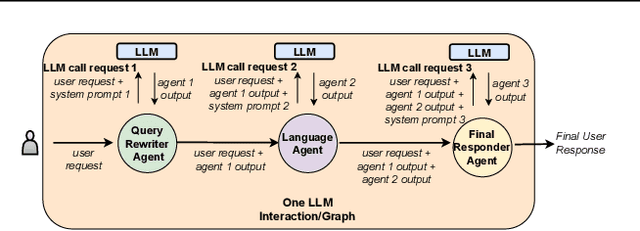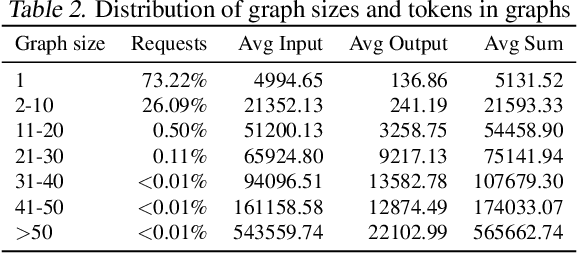Chetan Bansal
Anyprefer: An Agentic Framework for Preference Data Synthesis
Apr 27, 2025Abstract:High-quality preference data is essential for aligning foundation models with human values through preference learning. However, manual annotation of such data is often time-consuming and costly. Recent methods often adopt a self-rewarding approach, where the target model generates and annotates its own preference data, but this can lead to inaccuracies since the reward model shares weights with the target model, thereby amplifying inherent biases. To address these issues, we propose Anyprefer, a framework designed to synthesize high-quality preference data for aligning the target model. Anyprefer frames the data synthesis process as a cooperative two-player Markov Game, where the target model and the judge model collaborate together. Here, a series of external tools are introduced to assist the judge model in accurately rewarding the target model's responses, mitigating biases in the rewarding process. In addition, a feedback mechanism is introduced to optimize prompts for both models, enhancing collaboration and improving data quality. The synthesized data is compiled into a new preference dataset, Anyprefer-V1, consisting of 58K high-quality preference pairs. Extensive experiments show that Anyprefer significantly improves model alignment performance across four main applications, covering 21 datasets, achieving average improvements of 18.55% in five natural language generation datasets, 3.66% in nine vision-language understanding datasets, 30.05% in three medical image analysis datasets, and 16.00% in four visuo-motor control tasks.
Synergistic Weak-Strong Collaboration by Aligning Preferences
Apr 22, 2025Abstract:Current Large Language Models (LLMs) excel in general reasoning yet struggle with specialized tasks requiring proprietary or domain-specific knowledge. Fine-tuning large models for every niche application is often infeasible due to black-box constraints and high computational overhead. To address this, we propose a collaborative framework that pairs a specialized weak model with a general strong model. The weak model, tailored to specific domains, produces initial drafts and background information, while the strong model leverages its advanced reasoning to refine these drafts, extending LLMs' capabilities to critical yet specialized tasks. To optimize this collaboration, we introduce a collaborative feedback to fine-tunes the weak model, which quantifies the influence of the weak model's contributions in the collaboration procedure and establishes preference pairs to guide preference tuning of the weak model. We validate our framework through experiments on three domains. We find that the collaboration significantly outperforms each model alone by leveraging complementary strengths. Moreover, aligning the weak model with the collaborative preference further enhances overall performance.
AMPO: Active Multi-Preference Optimization
Feb 25, 2025Abstract:Multi-preference optimization enriches language-model alignment beyond pairwise preferences by contrasting entire sets of helpful and undesired responses, thereby enabling richer training signals for large language models. During self-play alignment, these models often produce numerous candidate answers per query, rendering it computationally infeasible to include all responses in the training objective. In this work, we propose $\textit{Active Multi-Preference Optimization}$ (AMPO), a novel approach that combines on-policy generation, a multi-preference group-contrastive loss, and active subset selection. Specifically, we score and embed large candidate pools of responses and then select a small, yet informative, subset that covers reward extremes and distinct semantic clusters for preference optimization. Our contrastive training scheme is capable of identifying not only the best and worst answers but also subtle, underexplored modes that are crucial for robust alignment. Theoretically, we provide guarantees for expected reward maximization using our active selection method, and empirically, AMPO achieves state-of-the-art results on $\textit{AlpacaEval}$ using Llama 8B.
Time Warp: The Gap Between Developers' Ideal vs Actual Workweeks in an AI-Driven Era
Feb 21, 2025Abstract:Software developers balance a variety of different tasks in a workweek, yet the allocation of time often differs from what they consider ideal. Identifying and addressing these deviations is crucial for organizations aiming to enhance the productivity and well-being of the developers. In this paper, we present the findings from a survey of 484 software developers at Microsoft, which aims to identify the key differences between how developers would like to allocate their time during an ideal workweek versus their actual workweek. Our analysis reveals significant deviations between a developer's ideal workweek and their actual workweek, with a clear correlation: as the gap between these two workweeks widens, we observe a decline in both productivity and satisfaction. By examining these deviations in specific activities, we assess their direct impact on the developers' satisfaction and productivity. Additionally, given the growing adoption of AI tools in software engineering, both in the industry and academia, we identify specific tasks and areas that could be strong candidates for automation. In this paper, we make three key contributions: 1) We quantify the impact of workweek deviations on developer productivity and satisfaction 2) We identify individual tasks that disproportionately affect satisfaction and productivity 3) We provide actual data-driven insights to guide future AI automation efforts in software engineering, aligning them with the developers' requirements and ideal workflows for maximizing their productivity and satisfaction.
Verifiable Format Control for Large Language Model Generations
Feb 06, 2025Abstract:Recent Large Language Models (LLMs) have demonstrated satisfying general instruction following ability. However, small LLMs with about 7B parameters still struggle fine-grained format following (e.g., JSON format), which seriously hinder the advancements of their applications. Most existing methods focus on benchmarking general instruction following while overlook how to improve the specific format following ability for small LLMs. Besides, these methods often rely on evaluations based on advanced LLMs (e.g., GPT-4), which can introduce the intrinsic bias of LLMs and be costly due to the API calls. In this paper, we first curate a fully verifiable format following dataset VFF. In contrast to existing works often adopting external LLMs for instruction-following validations, every sample of VFF can be easily validated with a Python function. Further, we propose to leverage this verifiable feature to synthesize massive data for progressively training small LLMs, in order to improve their format following abilities. Experimental results highlight the prevalent limitations in the format following capabilities of 7B level open-source LLMs and demonstrate the effectiveness of our method in enhancing this essential ability.
Towards Efficient Large Multimodal Model Serving
Feb 02, 2025Abstract:Recent advances in generative AI have led to large multi-modal models (LMMs) capable of simultaneously processing inputs of various modalities such as text, images, video, and audio. While these models demonstrate impressive capabilities, efficiently serving them in production environments poses significant challenges due to their complex architectures and heterogeneous resource requirements. We present the first comprehensive systems analysis of two prominent LMM architectures, decoder-only and cross-attention, on six representative open-source models. We investigate their multi-stage inference pipelines and resource utilization patterns that lead to unique systems design implications. We also present an in-depth analysis of production LMM inference traces, uncovering unique workload characteristics, including variable, heavy-tailed request distributions, diverse modal combinations, and bursty traffic patterns. Our key findings reveal that different LMM inference stages exhibit highly heterogeneous performance characteristics and resource demands, while concurrent requests across modalities lead to significant performance interference. To address these challenges, we propose a decoupled serving architecture that enables independent resource allocation and adaptive scaling for each stage. We further propose optimizations such as stage colocation to maximize throughput and resource utilization while meeting the latency objectives.
AIOpsLab: A Holistic Framework to Evaluate AI Agents for Enabling Autonomous Clouds
Jan 12, 2025



Abstract:AI for IT Operations (AIOps) aims to automate complex operational tasks, such as fault localization and root cause analysis, to reduce human workload and minimize customer impact. While traditional DevOps tools and AIOps algorithms often focus on addressing isolated operational tasks, recent advances in Large Language Models (LLMs) and AI agents are revolutionizing AIOps by enabling end-to-end and multitask automation. This paper envisions a future where AI agents autonomously manage operational tasks throughout the entire incident lifecycle, leading to self-healing cloud systems, a paradigm we term AgentOps. Realizing this vision requires a comprehensive framework to guide the design, development, and evaluation of these agents. To this end, we present AIOPSLAB, a framework that not only deploys microservice cloud environments, injects faults, generates workloads, and exports telemetry data but also orchestrates these components and provides interfaces for interacting with and evaluating agents. We discuss the key requirements for such a holistic framework and demonstrate how AIOPSLAB can facilitate the evaluation of next-generation AIOps agents. Through evaluations of state-of-the-art LLM agents within the benchmark created by AIOPSLAB, we provide insights into their capabilities and limitations in handling complex operational tasks in cloud environments.
REFA: Reference Free Alignment for multi-preference optimization
Dec 20, 2024Abstract:We introduce REFA, a family of reference-free alignment methods that optimize over multiple user preferences while enforcing fine-grained length control. Our approach integrates deviation-based weighting to emphasize high-quality responses more strongly, length normalization to prevent trivial short-response solutions, and an EOS-probability regularizer to mitigate dataset-induced brevity biases. Theoretically, we show that under the Uncertainty Reduction with Sequence Length Assertion (URSLA), naive length normalization can still incentivize length-based shortcuts. By contrast, REFA corrects these subtle incentives, guiding models toward genuinely more informative and higher-quality outputs. Empirically, REFA sets a new state-of-the-art among reference-free alignment methods, producing richer responses aligned more closely with human preferences. Compared to a base supervised fine-tuned (SFT) mistral-7b model that achieves 8.4% length-controlled win rate (LC-WR) and 6.2% win rate (WR), our best REFA configuration attains 21.62% LC-WR and 19.87% WR on the AlpacaEval v2 benchmark. This represents a substantial improvement over both the strongest multi-preference baseline, InfoNCA (16.82% LC-WR, 10.44% WR), and the strongest reference-free baseline, SimPO (20.01% LC-WR, 17.65% WR)
SWEPO: Simultaneous Weighted Preference Optimization for Group Contrastive Alignment
Dec 05, 2024Abstract:We introduce Simultaneous Weighted Preference Optimization (SWEPO), a novel extension of Direct Preference Optimization (DPO) designed to accommodate multiple dynamically chosen positive and negative responses for each query. SWEPO employs a weighted group contrastive loss, assigning weights to responses based on their deviation from the mean reward score. This approach effectively prioritizes responses that are significantly better or worse than the average, enhancing optimization. Our theoretical analysis demonstrates that simultaneously considering multiple preferences reduces alignment bias, resulting in more robust alignment. Additionally, we provide insights into the training dynamics of our loss function and a related function, InfoNCA. Empirical validation on the UltraFeedback dataset establishes SWEPO as state-of-the-art, with superior performance in downstream evaluations using the AlpacaEval dataset.
Ensuring Fair LLM Serving Amid Diverse Applications
Nov 24, 2024



Abstract:In a multi-tenant large language model (LLM) serving platform hosting diverse applications, some users may submit an excessive number of requests, causing the service to become unavailable to other users and creating unfairness. Existing fairness approaches do not account for variations in token lengths across applications and multiple LLM calls, making them unsuitable for such platforms. To address the fairness challenge, this paper analyzes millions of requests from thousands of users on MS CoPilot, a real-world multi-tenant LLM platform hosted by Microsoft. Our analysis confirms the inadequacy of existing methods and guides the development of FairServe, a system that ensures fair LLM access across diverse applications. FairServe proposes application-characteristic aware request throttling coupled with a weighted service counter based scheduling technique to curb abusive behavior and ensure fairness. Our experimental results on real-world traces demonstrate FairServe's superior performance compared to the state-of-the-art method in ensuring fairness. We are actively working on deploying our system in production, expecting to benefit millions of customers world-wide.
 Add to Chrome
Add to Chrome Add to Firefox
Add to Firefox Add to Edge
Add to Edge